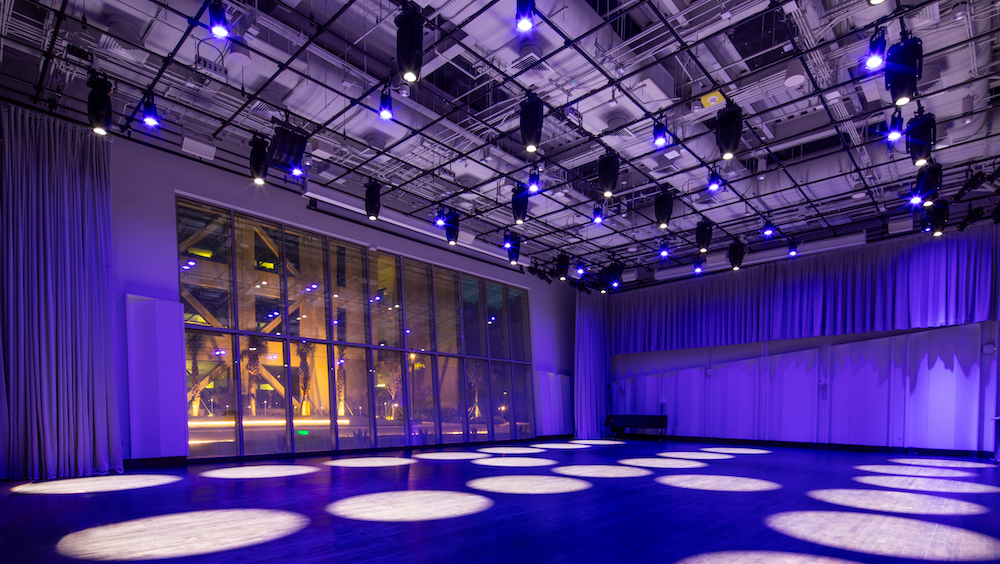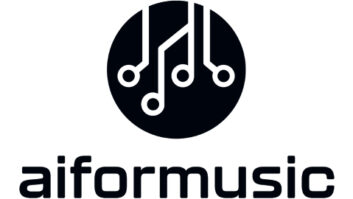
Miami, FL (June 28, 2024)—Music has been an integral part of the University of Miami since it opened in 1926 with two academic units: the College of Arts and Sciences and the Conservatory of Music. Nearly a century later, that commitment to music has been updated for the next 100 years with the November 2023 unveiling of the Frost School of Music’s new Knight Center for Music Innovation.
Designed by H3, an Arquitectonica Company, the 25,000-square-foot facility includes two performance spaces: the Newman Recital Hall, an intimate 200-seat performance theater with superior acoustics, and the Thomas D. Hormel Music Innovation Stage, a spacious, configurable room for a multitude of musical performance possibilities. “I don’t know if there is a space in all of South Florida where chamber music will sound better than the Robert and Judi Prokop Newman Recital Hall; it’s just a pristine listening experience,” says Reynaldo Sanchez, Associate Dean for Strategic Initiatives and Innovation, professor at Frost School of Music and a music producer. “This journey began all the way back in 1965, when Bill Lee was hired as Dean, and we started all these cool programs that we have now. Our music engineering program was launched in, I believe it was 1977 or ’78, and we were the first in the country!”
William “Bill” Lee was the music school Dean from 1964 to 1982. In 1976, he invited Nashville sound engineer Bill Porter—known for recording hits by Roy Orbison, the Everly Brothers and Elvis Presley, among many others—to help shape the early Music Engineering Technology program at the Frost School of Music. Ken Pohlmann, a former Mix columnist, taught one of the first university-level courses in digital audio in the mid-1970s, and became a guiding force in the early music engineering curricula.
Construction of the Knight Center, meanwhile, was driven by Frost’s current Dean, Shelton “Shelly” Berg, an award-winning jazz pianist and composer himself, who pushed for superior room acoustics and technological innovations. He was assisted by Associate Dean of Administration at Frost, Serona Elton, who pulls double-duty as Director of the Music Industry Department. “I was hands-on in working with the various teams that are outside of Frost to get the building fully operational,” Elton explains. “The building has two large event spaces that serve very different purposes. One end of the building is the Newman Recital Hall—a beautiful, visually stunning hall that is meant for acoustic music.
It’s a more intimate space. At the other end of the building is the Hormel Music Innovation Stage. It’s not a stage in the traditional sense; it’s this very versatile space that can be used for a variety of different kinds of events. Calling it a multipurpose room is sort of an understatement because it’s so much more interesting than that: You can put on a rock concert in there. You could create a jazz club vibe. You could also have a conference session.
“Each of those two event spaces have their own audio control room, as well as a separate video-lighting projection control room,” she continues. “There are also supporting spaces in between the rooms—a green room, several dressing rooms, and a practice room—and most of the rooms are networked in some way, whether it’s that they have a monitor on the wall that has a live feed from another [performance space], or they’re fully wired into and could be used for recording somebody in those spaces.”

ACOUSTICAL DESIGN
“There are actually two buildings there,” says acoustician Russell Todd of Akustiks, South Norwalk, Conn., who, along with partner Paul Scarborogugh, has acoustic design credits that include Nashville Symphony Hall and the David Geffen Hall at NYC’s Lincoln Center. “The best way to think of it is as a barbell. You have the Newman and the Hormel, and between them is this bar with all the mechanicals serving the hall—the elevator, air conditioning, all the mechanical noise—on the roof of the lobby between the recital halls so that noise or vibrations can’t cross over to either recital hall.
“In Newman Hall, the ceiling averages about 40 feet,” Todd continues, “and it’s a tilted roof, which helps to keep energy forward in the room. The side walls that are adjacent to the audience are very specifically shaped to provide lateral acoustical reflections. I’m a New England guy, and it comes from the design of traditional boat hulls—planks that are bent and curved. I discussed this with [principal H3 architect] Ariel Fausto, and that’s the architectural inspiration. The walls are compound-curved in sections, and it sends some of that energy into the upper, reverberant chamber of the room, and decreases the harshness to the audience.”
One of Dean Berg’s requests/visions for the Newman was the addition of a pipe organ, but not just any pipe organ. “At the very outset, Dean Berg wanted to have an organ in the space, an electronic organ specifically,” Todd says. “We worked with Marshall and Ogletree to design how that Opus digital organ would be integrated into the room seamlessly. Ariel Fausto designed that wood facade in a way that looks like a pipe organ.
The geometry of it—the wood slats as pipes going up—gives the visual impression of a pipe organ, and all of the drivers for the electronic organ reside behind the wood walls that flank the stage.“ Frost Director of Production Services Dana Salminen especially appreciates the adjustable acoustics in Newman Hall: “On the left and right sides of the hall, you have acoustic curtains,” Salminen notes. “We can raise and lower to adjust the acoustics in the room, primarily to simulate an audience when somebody is having a rehearsal and the hall is empty. Those curtains are meant to simulate what that hall is gonna sound like when it’s full of people.”
HORMEL MUSIC INNOVATION STAGE
“What’s neat in Hormel,” Salminen says, switching gears, “is that we have a pipe grid across the ceiling where we can hang additional cameras, lighting projectors, whatever’s needed for that specific event, as well as having lots of different power and data connections at all different locations. That’s the whole point of this space: We did not want to be locked into any specific orientation or a way that everything had to be set up.”
Sanchez adds, “This room could be configured any way we want for musical performances, but it’s also great for immersive multimedia experiences. We have walls we could project onto. The floors and the ceiling are black and the walls are white, and there’s no fixed seating.”
Other Hormel Innovation Stage use cases include orchestral scoring to picture, as it can hold an 80-piece orchestra, and it has projection, lighting and networking capabilities. One difference between the two performance spaces from an acoustical design perspective was the creation of glass walls that would also serve as projection and broadcasting locations.
“The glass wall in Hormel is tilted, and in Newman, it is not,” says acoustician Todd. “In Newman, the glass is flat because the surface opposite the glass is the audience, which is absorptive. In Hormel, the surface opposite the glass is another vertical wall—there is no raised audience floor [like in Newman]. You don’t have the raised audience situation, and there’s no absorption, so I tilted the glass [to reflect sound] up into the reverberant sound field so as not to create a flutter echo.”
While both performance spaces are equipped with the latest state-of-the-art cameras, microphones, lighting, and racks of outboard gear, the real technological star of the Knight Center for Music Innovation is invisible. “The most important thing in that space is the thing you can’t see, which is the infrastructure,” Sanchez notes. “The whole space runs on a Dante network, which is extremely flexible. What we didn’t want was the old school of running copper wires everywhere. Dante is perfect because we can put stage boxes wherever we want. We can put speakers wherever we want. All it takes is running a Cat-6 cable, just one basic networking cable, which is light, easy, cheap.”
“We have a really robust and future-proof infrastructure,” Salminen adds. “All of our switches are 10-gig switches. We have lots of data that can go basically anywhere in the entire building. What that allows us to do is, if we want to send the video image from one hall to a different hall, no problem.”

OPENING UP
In November 2023, the Knight Center opened with a week-long series of events and concerts featuring musical performances from the Frost School of Music’s illustrious alumni and faculty showcasing the multimillion-dollar facility’s spectacular acoustics and futuristic multimedia capabilities.
“We had our wonderful opening gala,” Salminen recalls. “We had a concert with our alumni superstars, which included people like Jon Secada and Gloria Estefan, and other large jazz and contemporary acts. At one point, we had 22 musicians on stage, almost like a small pop orchestra playing, and even with minimal amplification, everything sounded great! “From day one, our team had to plan how to achieve Dean Berg’s dreams and goals of making this an innovative and incredible space, but also make it simple and user-friendly enough that a 20-year-old kid can operate the technology,” he continues. “Can they operate it? Can they troubleshoot it? It’s not just a performing center.
This is a school, and we want the students to learn and have real-life experience. “What I think is really unique and wonderful is that we have a small group of extensively trained student engineers who help us actually do the events. There’s no physical way for us to handle the number of events that we do. We get them up to a professional level, where they’re putting out content on a daily basis that I think rivals all the professional halls out there. This small army of extensively trained student engineers is kind of the hidden side of all this new tech and these wonderful new spaces!”
Inside Sony 5020 Studios Madrid
On one side of the Knight Center—the Hormel Stage side—is a two-story-high glass wall, dubbed the Windowcast, that faces a student plaza surrounded by speakers. The large panes of glass can switch from clear to opaque, and then the performances can be shared with the campus passersby. “The first night that we did it, there was a great moment,” Sanchez recalls. “A little kid, two or three years old, walks up to the window that we are casting the orchestra onto. The orchestra is happening over in Gusman Hall, and there are multiple cameras. You see the conductor up there conducting. And this little kid—while the orchestra’s playing and the conductor’s conducting—he walks up to the window and starts conducting. That was just an awesome moment! That’s precisely what we set out to accomplish with this Windowcast—this engagement of people like that little kid who otherwise would have never been in the concert. The idea is to bring the inside out.”
Says Todd, in summary, “To me, what’s really exciting is to see what will happen in the future, what the creative minds at the school—both the professors and the students—will do with the rooms. I look at the whole building like a canvas that will allow them to paint on it, both with natural orchestral acoustics and also with the integration of video and all the emerging new technologies.”







